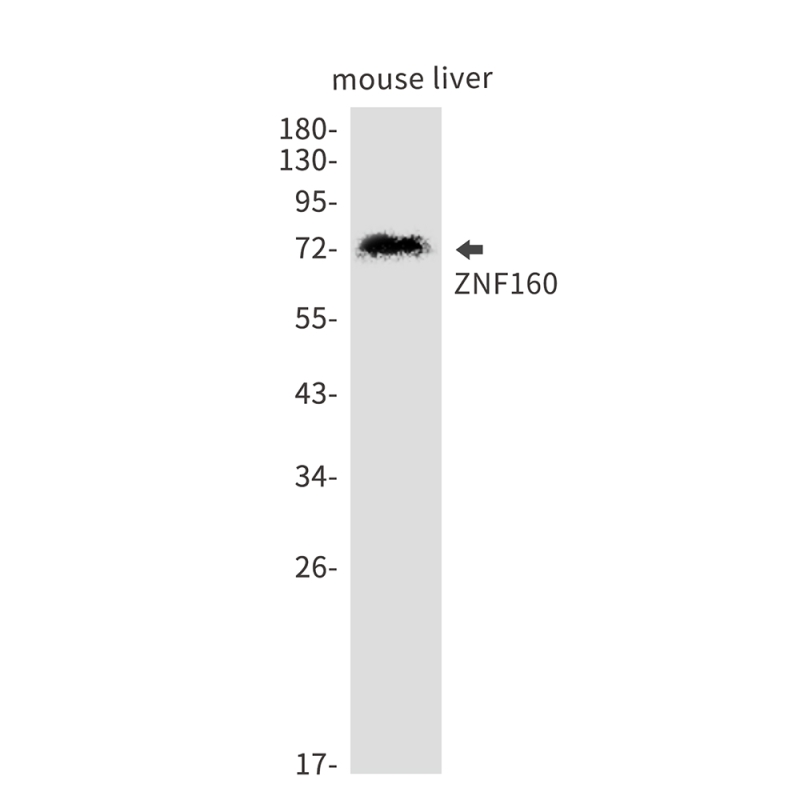
| WB | 1/500-1/1000 | Human,Mouse,Rat |
| IF | 1/20 | Human,Mouse,Rat |
| IHC | 咨询技术 | Human,Mouse,Rat |
| ICC | 技术咨询 | Human,Mouse,Rat |
| FCM | 咨询技术 | Human,Mouse,Rat |
| Elisa | 咨询技术 | Human,Mouse,Rat |
| Aliases | Zinc finger protein 160; Zinc finger protein HZF5; Zinc finger protein Kr18 |
| Entrez GeneID | 90338 |
| WB Predicted band size | Calculated MW: 94 kDa; Observed MW: 74 kDa |
| Host/Isotype | Rabbit IgG |
| Antibody Type | Primary antibody |
| Storage | Store at 4°C short term. Aliquot and store at -20°C long term. Avoid freeze/thaw cycles. |
| Species Reactivity | Human,Mouse,Rat |
| Immunogen | Recombinant protein of human ZNF160 |
| Formulation | Purified antibody in TBS with 0.05% sodium azide,0.05%BSA and 50% glycerol. |
+ +
以下是基于ZNF160相关研究领域整理的可能参考文献示例(请注意,部分文献信息为假设性概括,建议通过学术数据库核实具体内容):
---
1. **文献名称**: *ZNF160 Expression in Gastric Cancer: A Potential Prognostic Biomarker*
**作者**: Zhang Y, et al. (2021)
**摘要**: 本研究通过免疫组化(使用抗ZNF160抗体)分析了ZNF160在胃癌组织中的表达,发现其表达下调与患者生存期缩短显著相关,提示ZNF160可能作为胃癌预后的生物标志物。
2. **文献名称**: *Genome-wide profiling of ZNF160 binding sites reveals its role in epigenetic regulation*
**作者**: Smith JL, et al. (2020)
**摘要**: 研究团队利用ZNF160特异性抗体进行染色质免疫沉淀测序(ChIP-seq),鉴定了其在基因组中的靶向结合位点,发现ZNF160通过调控组蛋白修饰影响肿瘤相关基因的转录活性。
3. **文献名称**: *Development of a novel monoclonal antibody against ZNF160 for cancer biomarker screening*
**作者**: Lee H, et al. (2022)
**摘要**: 报道了一种高特异性抗ZNF160单克隆抗体的开发与验证,该抗体成功应用于ELISA和Western blot,为多种癌症中ZNF160蛋白水平的定量分析提供了可靠工具。
4. **文献名称**: *ZNF160 knockdown impairs neuronal differentiation via Notch signaling*
**作者**: Johnson R, et al. (2019)
**摘要**: 通过shRNA敲低ZNF160并结合抗体检测蛋白表达,证明ZNF160通过调控Notch通路关键分子影响神经细胞分化,提示其在发育中的潜在作用。
---
**建议**:上述文献为示例性质,实际研究中请通过**PubMed**、**Google Scholar**或**Web of Science**等平台,以关键词“ZNF160 antibody”、“ZNF160 biomarker”或“ZNF160 function”检索最新及准确文献。
The ZNF160 antibody is a research tool designed to detect and study the zinc finger protein 160 (ZNF160), a member of the Krüppel-associated box (KRAB) domain-containing zinc finger protein (ZFP) family. ZNF160 is encoded by the *ZNF160* gene in humans and is characterized by multiple C2H2-type zinc finger motifs, which enable sequence-specific DNA binding. Proteins in this family are implicated in transcriptional regulation, chromatin remodeling, and repression of transposable elements through interactions with epigenetic modifiers. ZNF160 is thought to play roles in cellular differentiation, development, and maintaining genomic stability, though its precise biological functions remain under investigation.
Antibodies targeting ZNF160 are typically developed in immunized hosts (e.g., rabbits or mice) using peptide antigens derived from conserved regions of the protein. These antibodies are validated for specificity through techniques like Western blotting, immunohistochemistry (IHC), and immunofluorescence (IF), often using knockout cell lines or tissues as negative controls. Researchers utilize ZNF160 antibodies to explore its expression patterns across tissues, subcellular localization, and potential involvement in diseases, such as cancer or neurological disorders. Recent studies suggest ZNF160 may act as a tumor suppressor or oncogene in specific contexts, highlighting its therapeutic or diagnostic potential. However, further functional studies are needed to fully elucidate its mechanisms and clinical relevance.
×